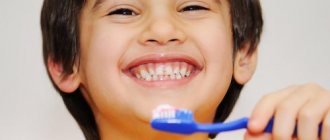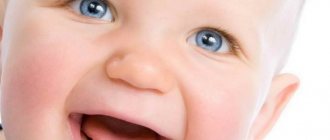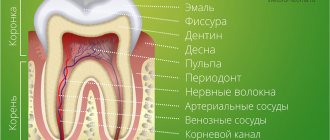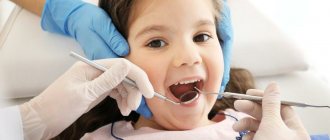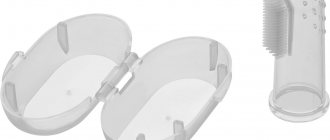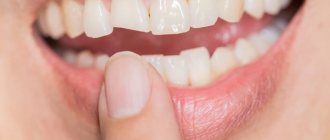Children's teeth appear in a certain sequence and in pairs (for example, two central incisors or two canines). But often the timing of teething in children shifts upward: many parents begin to worry and get nervous, but this is not worth doing, since the deviation from the norm is explained by the individual characteristics of the body, the uncharacteristic course of pregnancy, or various injuries received during childbirth.
Teething in children and features of this process
Quite often, a few weeks before the appearance of a baby or molar tooth, a lump filled with a clear or bluish liquid forms on the gum. Naturally, it worries parents, but there is no pathology in this formation, and the lump, which does not look very aesthetically pleasing, does not indicate the beginning of the inflammatory process. In most cases, no intervention by a doctor is required. You can contact the dentist if the lump increases in size: the doctor will make a small incision and release the liquid.
Milk and molar teeth in children
Many people believe that there are no differences between permanent and temporary teeth, but this is not true. So, how to distinguish a baby tooth from a molar? At a minimum, their number differs (milk - 20, permanent, as a rule, 32). Temporary teeth have a light shade, while permanent teeth are naturally more yellow. Indigenous ones are also significantly larger in size than dairy ones - visually it is quite easy to distinguish them. Here are the most common questions asked by Internet users on this topic.
- Do children have molars?
Of course, there are, and at a certain point they begin to actively erupt. - How many molars do children have?
From 28 to 32 (the maximum set appears after all eights appear). - Which molars appear first in a child?
Typically, the lower central incisor erupts first. - At what age do children start to get their molars?
Usually, dentition renewal begins after 6–7 years, but there are no strict limits. - Do children lose molars?
By themselves - no, as a result of injuries and illnesses - yes. - What are the risks of removing a molar tooth in children?
As corny as it may sound, his loss. And yes, a new one will not grow. Everything is like adults. - What to do if a child has yellow molars?
Permanent teeth have a more yellowish tint than temporary teeth. Plaque on a child’s molars is normal, but hygiene should never be neglected. - What to do if a child has black molars?
When teething, baby teeth may have a black color (the so-called Priestley plaque, or pigment bacteria). However, this does not happen with molars. If they are black, go to the dentist immediately. - What to do if a child does not have molar buds?
This happens, but very rarely. Fortunately, with modern implantation and prosthetics technologies, the problem can be solved. - Is it normal for a child to have crooked molars?
Contact an orthodontist immediately: correcting a bite in childhood is much easier and faster than in adults. - Which teeth do children replace with molars?
All twenty, plus new molars appearing.
Baby teeth in children: order of eruption
Any newborn baby has follicles of milk teeth (20 pieces) and molars (16 pieces) inside the jaws. The remaining 16 rudiments will form later.
Teething in infants begins with the lower jaw: first the central incisors appear (6-10 months of the child’s life), then the canines (10-13 months), then comes the turn of the first (14-18 months) and second (17-23 months) molars .
Emerging teeth differ from adult teeth in having low-mineralized enamel. If you do not maintain oral hygiene, caries may begin to develop. In addition to careful adherence to hygiene rules, special gels and ointments that significantly accelerate the mineralization process will help make teeth stronger and more resistant to pathogenic microorganisms.
Dental development
The differences between primary and molar teeth begin with their number - only 20 primary teeth, 8 incisors and molars, and 4 canines. This is explained by the fact that children simply have nowhere to fit more teeth. In this regard, there are no primary premolars. By the time the permanent teeth appear, the adolescent's jaws are already sufficiently developed for all teeth to appear.
The formation of tooth buds in humans begins at the 6th week of intrauterine development, and at the 14th week hard dental tissue appears. The crown develops first. The development of the rudiments of permanent teeth begins in the 5th month.
By the time a child is born, the formation of the rudiments of both milk and permanent teeth is almost complete. The process of development of permanent teeth, which have no analogues among milk teeth, begins a year after birth.
While the first teeth may appear at 4 months, and their eruption may be delayed for up to a year, permanent teeth erupt in everyone at approximately the same age. The sequence of their eruption is the same as in the case of milkweeds:
- 6-7 years. The central incisors appear from below.
- 7-8 years old. The central incisors on top and the lateral incisors on the bottom are replaced.
- 8-9 years old. The lateral incisors of the upper jaw appear.
- 9-12 years old. Canines and premolars are replaced.
- From the age of 12. From this age, molars begin to change, and from about 14 years of age, teeth appear, which were not among the milk teeth.
Approximate timing of eruption of permanent teeth
The first of the molar permanent teeth to appear are molars (at the 6th year of life), located at the end of the dentition. But it is they who are most susceptible to caries, since there are deep depressions on their surface where bacteria accumulate due to poor cleaning and neglect of flossing.
The second molar appears 4-6 years later, when the child reaches 11-13 years of age. Incisors erupt at 6-8 years of a person’s life, canines - after 9 years of age.
Like newly emerged milk teeth, permanent teeth contain few minerals (a tenth of their amount in a mature adult). It is for this reason that it is important to teach a child proper hygiene. It wouldn’t hurt to treat your teeth with gels containing a large amount of fluoride once a quarter.
Consequences of premature removal of a baby tooth
These include:
- Bite disorders. Removing a tooth frees up space into which neighboring teeth gradually move. In the future, when a permanent tooth grows in instead of a temporary one, there will be no room left for its normal growth.
- Incorrect formation of the maxillofacial apparatus. Missing one or more teeth can result in insufficient stress being placed on the bone tissue, which in turn can slow down its growth and development.
- Disorders of the digestive system. The absence of one of the masticatory organs leads to poor chewing of food. This can cause a number of chronic diseases.
- Speech disorders. The incisors are part of the vocal apparatus, and the absence of one or more of them will certainly affect the development of speech.
- Psychological problems. The absence of a tooth in the smile area can cause some difficulties in communicating with peers and negatively affect the child’s self-esteem.
Therefore, the popular belief that there is nothing wrong with premature loss of baby teeth is completely wrong. A good dentist always carefully evaluates the feasibility of removing them and, if possible, tries to preserve them. The need for such a procedure must be confirmed by x-ray.
Teething in children: symptoms
The first signs of the imminent appearance of teeth appear about a week before their appearance. The symptoms will not stop until the tooth breaks through the gum lining.
Signs of teething in a baby are as follows:
- the child becomes irritable for no reason;
- sleep deteriorates (if the child cries at night and tosses and turns, there is no need to immediately start rocking him to sleep - it is better to give the baby the opportunity to calm down on his own);
- the gums become very swollen and swell at the site where the tooth appears;
- the appetite deteriorates, the baby may even refuse to eat altogether, feeling hungry;
- the child begins to chew on various objects to relieve severe itching in the gums;
- salivation increases;
- Due to drooling, a rash may appear around the mouth, chin and chest.
There are also additional ones, i.e. optional symptoms of teething in infants:
- heat. If the temperature has increased, this most likely indicates an inflammatory process that develops in parallel with teething and is in no way connected with it (it could be stomatitis or any cold).
When the temperature rises, you need to carefully examine the oral mucosa. If there are small bubbles filled with a cloudy liquid, erosion, and the gums themselves are bright red, then the child has herpetic stomatitis. Any baby receives antibodies to the herpes virus from its mother, but usually by the time the first teeth appear, their effect ends. Often the catalyzing factor in the development of stomatitis is trauma to the mucous membrane, which is inevitable when teeth appear. If the above signs cannot be detected, then it is recommended to give the baby Panadol (suppositories are the preferred form of medication). As practice shows, it is useless to call a pediatrician, since this is not their specialization. Only a dentist can determine the specific type of stomatitis (aphthous, herpetic, etc.).
- hematomas on the gums. Sometimes the gums become swollen, turning an eerie shade of blue. Despite their frightening appearance, hematomas do not require treatment. Doctor intervention is allowed only for large hematomas that do not decrease over a long time.
- vomit. The only acceptable cause of vomiting is excess saliva entering the stomach and esophagus. If vomiting begins against the background of elevated temperature and, especially, diarrhea, then these symptoms have nothing to do with teething - you need to call a doctor.
- coughing is not a natural cause when teeth appear, unless the child has swallowed saliva that has entered the respiratory tract.
- A runny nose is a sign of a cold, not teething.
Caring for children's teeth
The pattern of teething in children determines the approximate time of their appearance, but it is necessary to start observing oral hygiene as early as possible, without waiting for the teeth to erupt.
Breasts cannot take care of themselves, so they need help cleaning their gums. This is done either with the help of a fingertip, or, if there is none, with the help of an ordinary bandage dipped in warm boiled water and wound around the finger.
If teeth begin to erupt, you cannot do without the use of special products (baby pastes, brushes, etc.).
Eye teeth in older children
Permanent eye teeth erupt in children aged 9-12 years. Normal eye tooth eruption should occur painlessly. If pain still bothers the child, it may be caused by:
- the presence of infection in the oral cavity;
- periodontal disease;
- development of dental caries.
The eye teeth may erupt in a crooked manner. Orthodontic treatment helps correct abnormal tooth growth. If a tooth erupts and grows incorrectly, it is removed on the advice of a dentist. After removing an eye tooth, it must be immediately replaced with a prosthetic so as not to disrupt the integrity of the dentition and not to impair the process of chewing food.
Types of teething disorders
Teething in children, the sequence of which is clearly defined, can occur with a delay caused by various reasons (illness of the mother during pregnancy, diseases suffered by the child, etc.). Due to the delay, deformation of the jaws may begin, because There is not enough free space for teeth that have not yet erupted. In this case, only the dentist can decide on treatment after a thorough visual examination of the child and analysis of the photograph taken.
The next very common disorder is enamel hypoplasia, which manifests itself in spots of different colors on newly emerging teeth, pits or grooves. Hypoplasia causes complications during pregnancy.
Pattern of growth of molars in children
In most cases, the permanent tooth appears 3 to 5 months after the temporary tooth falls out. The order of eruption of molars is in many ways similar to the appearance of milk teeth. The first molars in children are the central lower incisors. The upper permanent teeth develop later than the lower ones, if we consider them in pairs.
| Age | Eruption of molars in children |
2 years | There have been references in history where a child was born with one or more molars. Cases when molars erupted in a 2-3 year old child also occur, but are extremely rare (less than 1%). |
5 years | When a child is 5 years old, molars very rarely come out (less than 10% of the total). If a baby tooth falls out on its own at such an early age, then there is every reason to believe that a permanent one will soon appear in its place. |
6 years | The roots of baby teeth (especially the upper and lower incisors) begin to dissolve and the teeth fall out. Usually, it is at the age of 6 that a child’s first molar begins to erupt. |
7 years | At this age, the first lower molars in children (at least one of them) have already erupted and the incisors of the upper jaw are next in line. |
9 years | At the age of 9, a child’s second molar should definitely have time to appear. Some children acquire lateral incisors and even a premolar on one of the jaws. |
10 years | At the age of ten, children’s back molars begin to actively erupt (premolars, and a little later – molars and canines). |
13 years | At 12–13 years of age, children usually develop a full bite of permanent teeth. The last teeth to emerge are usually the upper canines and second molars. This does not apply to wisdom teeth, which appear in adulthood (after 17–18 years) or may not erupt at all. |
Why do teeth erupt with irregularities?
The condition of a child’s teeth in the first years of life depends on the health of the mother during pregnancy. The formation of hard dental tissues may be disrupted if a woman:
- suffered from toxicosis at the initial stage of pregnancy;
- experienced severe prolonged stress;
- was treated for kidney disease;
- suffered from rubella.
In addition to maternal diseases, the maturation of teeth and the development of the jaw system can be affected by:
- fetal prematurity or, conversely, delayed birth;
- conflict of Rh factors;
- sepsis suffered by a child in the first month of life;
- frequent colds, pneumonia;
- convulsions;
- toxicosis;
- refusal to breastfeed.
Often, parents, driven by the best intentions, want to alleviate the baby’s suffering by giving him medications. You must understand that any medicine, even if it seems completely safe, cannot be taken without consulting a pediatrician!
